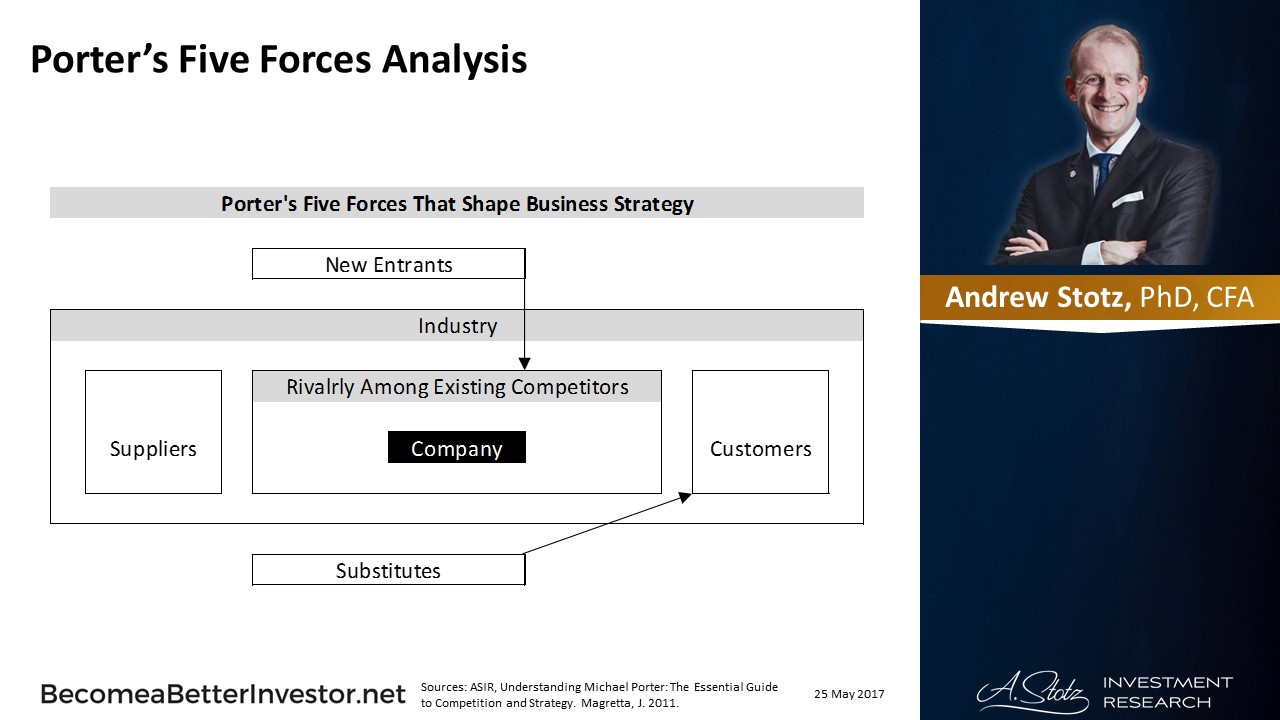Porter’s Five Forces That Shape Business Strategy
Watch the video with Andrew Stotz or read a summary of it below.
Porter’s Five Forces Analysis
Michael E. Porter’s five forces analysis is a framework for understanding the degree of competition in an industry. Strong forces drive down industry profitability.
The five forces model acknowledges that a company operates in a system of suppliers, customers, and existing competitors. In addition, there is always the threat of new entrants and in some cases substitutes.
Suppliers Bargaining Power
Powerful suppliers of the inputs to the company (raw materials, services, labor, etc.) may make an industry less attractive as they drive up prices and capture more of the industry’s profits. A strong “yes” answer to the following questions would imply strong supplier bargaining power, making the industry relatively unattractive.
- Do the suppliers have strong control of inputs that the company needs?
- Are there just one or two suppliers or is the industry fragmented?
- Are the inputs the company needs unique rather than commodity items?
Customer Bargaining Power
Powerful customers can force companies to reduce prices which can make an industry less attractive since the customers are able to take more of the industry’s profits. A strong “yes” answer to the following questions would imply strong customer bargaining power, making the industry relatively unattractive.
- Do the customers have many alternatives?
- Can the customers put pressure on the supplying companies?
- Are the customer’s switching costs low?
Threat of New Entrants
A profitable industry attracts new competitors; by adding supply or a differentiated option new competitors can drive down profits. If the threat of these new competitors is high then the industry could be less attractive. A strong “yes” answer to the following questions would imply a strong threat of new entrants, making the industry relatively unattractive.
- Is it easy for any company to enter the industry?
- Are there few intellectual property or knowledge industry entry barriers (e.g. patents, secrets, etc.)?
- Can any company get access to the raw materials and labor inputs of the process and start the business?
Threat of Substitutes
Substitute products are not direct rivals, but can closely meet the needs of the customers. They can reduce the power an incumbent company to raise prices and take profits from the industry. An example would be taking a plane vs a train from one city to another. A strong “yes” answer to the following questions would imply a strong threat of substitutes, making the industry relatively unattractive.
- Is it easy for the customer to interchange one product for another that does pretty much the same thing?
- Are the customer’s switching costs low?
- Is there little perceived difference in products?
- Are the prices of substitutes low relative to the incumbents?
Rivalry among Competitors
If existing companies are already competing intensely then this could drive down prices or make competing costlier, this would make the industry unattractive. A strong “yes” answer to the following questions would imply a strong rivalry among competitors, making the industry relatively unattractive.
- Are there many competitors of roughly equal size?
- Is it a slow growth industry?
- Are some competitors irrationally committed to the business (e.g. government-funded competitors)?
Learn more about Porter’s five forces:
Competitive Advantage: Creating and Sustaining Superior Performance, by Michael E. Porter
Understanding Michael Porter: The Essential Guide to Competition and Strategy, by Joan Magretta
DISCLAIMER: This content is for information purposes only. It is not intended to be investment advice. Readers should not consider statements made by the author(s) as formal recommendations and should consult their financial advisor before making any investment decisions. While the information provided is believed to be accurate, it may include errors or inaccuracies. The author(s) cannot be held liable for any actions taken as a result of reading this article.

